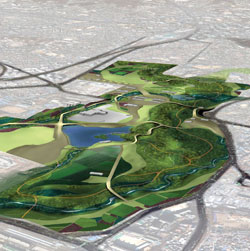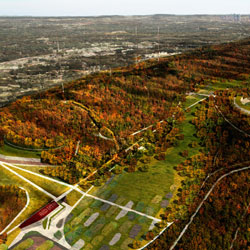With rapid global population growth and increasing urban and suburban
density, green spaces are sometimes seen as a luxury. However, high-performing green spaces, or green
infrastructure, provides real economic, ecological, and social benefits. Integrating green infrastructure into the built environment must be a priority.
Green
infrastructure can be considered a conceptual framework for
understanding the "valuable services nature provides the human
environment." At the regional or national levels, interconnected networks
of park systems and wildlife corridors preserve ecological function,
manage water, provide wildlife habitat, and create a balance between
built and natural environments.
At the urban level, urban
forestry and other means are central to reducing energy usage costs, managing stormwater, and creating clean,
temperate air.
Transportation networks can become green, with the addition of artful bioretention systems.
Lastly, green roofs, walls, and other techniques within
or on buildings bring a range of benefits, including reduced energy
consumption and dramatically decreased stormwater runoff. At all scales,
green infrastructure provides real ecological, economic, and social
benefits.
The benefits of green infrastructure are numerous. From the broadest environment benefits to site-specific ones, green
infrastructure is an effective and cost-efficient tool for absorbing and
sequestering atmospheric carbon dioxide (C02); filtering air and water pollutants; stabilizing soil to prevent or reduce erosion;
providing wildlife habitat; decreasing solar heat gain; lowering the public cost of stormwater
management infrastructure and providing flood control; and reducing energy usage through passive heating and
cooling.
Green infrastructure
is crucial to combating climate change, creating healthy
built environments, and improving quality of life.
Organizations
Resources
, The Conservation Fund
, U.S. Environmental Protection Agency
"," The Dirt blog
, Land Policy Institute
Interview with Congresswoman Donna Edwards on Green Infrastructure, ËżąĎĘÓƵ
Interview with Nina-Marie Lister, Affiliate ËżąĎĘÓƵ, on Ecological Urbanism, ËżąĎĘÓƵ
, Landscape Architecture Foundation
, Regional Plan Association
(SITES)
Government Resources
Research
 ËżąĎĘÓƵ 2011 Honor Award. The Regeneration / Yongsan Park, Seoul, South Korea. / Image credit: UnitedLAB, Seoul, South Korea and Isaac Brown Ecology Studio, Los Angeles.
ËżąĎĘÓƵ 2011 Honor Award. The Regeneration / Yongsan Park, Seoul, South Korea. / Image credit: UnitedLAB, Seoul, South Korea and Isaac Brown Ecology Studio, Los Angeles.
Columbia Water Center ¨C The Earth Institute, Columbia University, 2014
Water Environment Federation Stormwater Report - April 2014
World Resources Institute, 2013
The Nature Conservancy, 2013
The Nature Conservancy with Dow, Swiss Re, Shell, and Unilever Companies, 2013
U.S. Environmental Protection Agency, 2013
World Resources Institute, 2013
ˇ°Banking on Green: A Look at How Green Infrastructure Can Save Municipalities Money and Provide Economic Benefits Community-wide,ˇ± ËżąĎĘÓƵ, 2013
U.S. Environmental Protection Agency, 2013
Natural England, 2012
USDA Forest Service, New York University, University of Buffalo, 2012
Natural Resources Defense Council, 2011 []
The Center for Clean Air
Policy, February 2011
"," Environmental Defense Fund, 2010
"," Center for Neighborhood Technology and American Rivers, 2010
"," Center for Neighborhood Technology, 2009
Role of the Landscape Architect
 ËżąĎĘÓƵ 2012 Honor Award. Red Mountain / Green Ribbon ˇŞ The Master Plan for Red Mountain Park, Birmingham, Alabama / Image credit: WRT, Philadelphia
ËżąĎĘÓƵ 2012 Honor Award. Red Mountain / Green Ribbon ˇŞ The Master Plan for Red Mountain Park, Birmingham, Alabama / Image credit: WRT, Philadelphia
Landscape architects plan, design, and implement green infrastructure at all scales. Landscape architects work with policymakers, planners, architects, engineers, ecologists, scientists, and
horticulturalists to implement
best practices for green infrastructure systems and designs, ensuring these systems deliver benefits to both natural wildlife and human communities.
Landscape architects are involved in regional master planning, conservation and restoration efforts, urban design, and park and green roof design and construction. At all scales, they bring a critical eye for social and artistic value to the design process.
Projects
Open Space Seattle 2100 Envisioning Seattle's Green Infrastructure for the Next Century,
Seattle, Washington (Department of Landscape Architecture, University
of Washington, and the Open Space Seattle 2100 Coalition)
Coastal Roulette: Planning Resilient Communities for Galveston Bay, Galveston Bay, TX
(SWA Group)
, Planning District 16, Virginia.
Forests & Nature Reserves >>